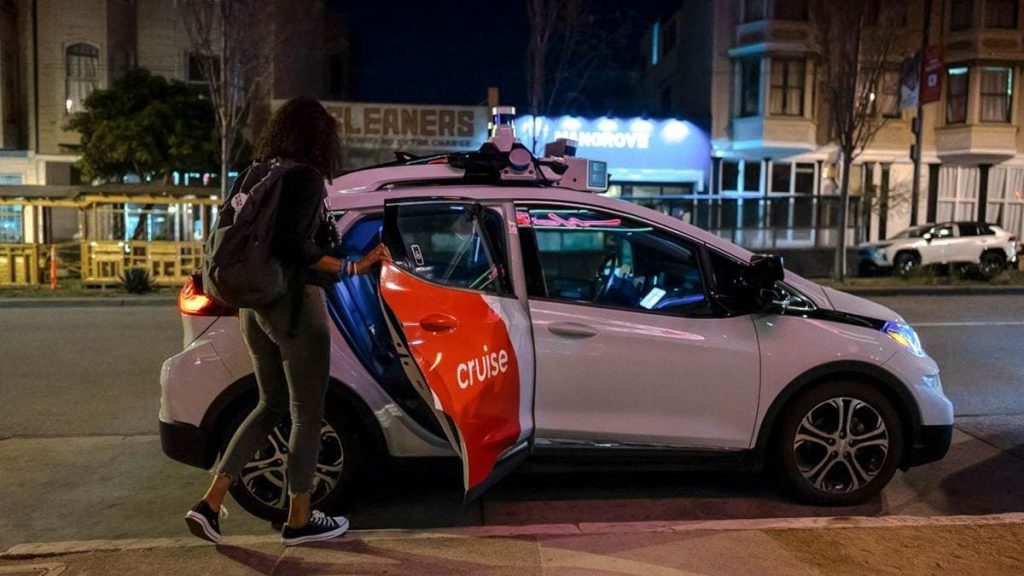Around 10pm Thursday evening, a San Francisco Fire Dept. ladder truck T-boned a Cruise robotaxi, making physical the accelerating battle between the SFFD and the robotaxi companies. Airbags were deployed and a passenger in the Cruise complained of a headache and was taken to hospital; no further details were released.
The accident is complex, and there may be potential fault for both vehicles, but mostly for the Fire Department. The Cruise Chevy Bolt was traveling down a one-way street (Turk) going through an intersection with a green light, according to Cruise. The Fire Engine was on call on Polk St. A witness reports it had sirens going. Approaching the red light, the fire truck appears to have moved to the opposite lane to clear traffic and cross the intersection through the red light.
The intersection has tall buildings at the corners making the corners “blind.” Vehicles on Turk such as the Bolt can’t see an approaching vehicle on Polk, particularly on the right side. The Bolt was also apparently in the right lane, based on the final geometry of the vehicles. The fire truck hit the rear right side of the Bolt, apparently spinning it about 45 degrees, but the fire engine did not travel very far into the intersection in spite of its larger mass.
When an emergency vehicle is running code with a visible light and sirens, other vehicles are required to yield to it and pull off the road as needed. However, this does not mean emergency vehicles can run through red lights and stop signs. The normal red light rules do not apply, but the procedure is for the vehicle to slow, make special sounds (honk or modulate siren) and confirm the intersection is clear, then proceed.
Ideally, the Cruise vehicle should have reacted to sirens and slowed as it came to the crosswalk, where it would have seen the fire engine and stopped. The fire engine should have slowed at its own crosswalk and should have stopped when it saw the Bolt going through the intersection. Neither happened, resulting in a collision. Cruise tweeted that they believed any injuries were non-serious.
While the vehicle should have slowed, it may not be legally required to yield. The California vehicle code requires yielding to an emergency vehicle if it is both sounding sirens and has a visible red light. The lights on this vehicle were apparently not visible until it was close to the intersection. Cruise promotes that it takes extra effort to detect emergency vehicles, so one might argue it should have slowed, but it was probably not legally required to.
Bill Billuomini, who was working at the front desk of the Embassy hotel at the intersection, reported that the sirens were load and present for a reasonable amount of time prior to the impact, which he heard inside the hotel. Cruise vehicles are equipped with microphones to listen for sirens and attempt to determine their direction even when the vehicle can’t be seen, but for reasons not outlined by Cruise, the vehicle decided to proceed through the green light. It did not visually see the fire engine until roughly 1.5 seconds prior to the impact, it was reported.
Cruise has had a terrible week in the news. It began well, with the granting of an expanded permit for operations in San Francisco and announcements of expansion into new regions, such as Charlotte. It also included a vehicle driving into wet concrete at a construction zone, a traffic jam of 5 vehicles in the North Beach area first blamed on communications problems, but later revealed to be caused intentionally by a pedestrian. At the same time, communications problems did cause delays in resolving problems in the heavy traffic outside a music festival. Thursday night also saw a collision with a car allegedly running a red light at high speed.
This fire truck collision is a terrible cap to the week due to the conflict between the city and Fire Department of San Francisco and the robotaxi companies. In fact, this particular truck, Engine #3, was spoken about at length during last week’s CPUC hearings as one of the busiest and most important in the country. It was not damaged, but it was delayed in its response to a call. The crash took place just blocks from City Hall and the CPUC offices, to pile on the irony.
In additinon, even though the city’s pleas were mostly disregarded at the CPUC, the city is stepping up their efforts with more petitions to scale back operations in their town.
Waymo representatives believe their vehicle would have handled this situation. According to Waymo, “Waymo has developed various technologies to detect active emergency vehicles even if they are not in direct view. Like humans, our vehicles can hear sirens and reason about the direction, location, and motion of the active emergency vehicle, importantly including whether it is approaching or receding. When we hear sirens, our vehicle will slow and then depending on how the situation develops, we will either pull over or stop ahead of intersections where there might be crossing emergency vehicles, even if we have a green light. The system is designed to remain cautious and not enter an intersection if it is still reasoning whether the emergency vehicle is approaching the intersection based on what it is sensing.” However, it is fair to say that Cruise has said similar things about their own vehicles ability to detect emergency vehicles, and Waymo has not tested in this exact situation.
The reason the Cruise vehicle did not slow is unclear and Cruise has not responded to requests for comment. Human drivers don’t stop every time they hear a siren in a dense city, so it’s possible that because the car could not see the truck, nor get a good read on its direction in the echos of urban canyons that it decided it should not yet slow. Some have wondered if the fact that the fire truck was in the opposite lane might have confused the logic in the vehicle, but that is not in any way confirmed.
It’s less clear if the Fire Dept., if at fault, will need to pay for the damage. Emergency workers are given a special qualified immunity under the law which can remove this liability. That will be a subject for negotiation.
Analysis
- Under the legal codes, probably the fault of the fire truck.
- The Cruise vehicle, with sirens this loud, should probably have made an effort to slow upon entering the crosswalk so that, once it saw the truck, it could brake in time.
- The Fire Engine should definitely not have entered the intersection without confirming it was clear.
- This is not going to improve relations between Cruise and the SFFD!
Read the full article here










